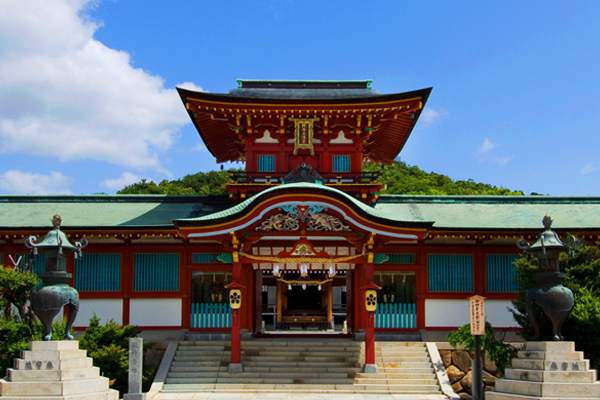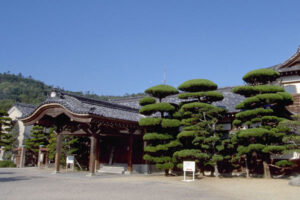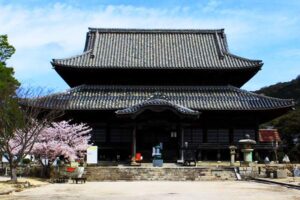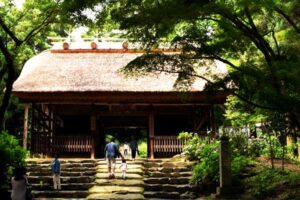The first of 12,000 Tenjin shrines in Japan
Origin Story/Overview
The first of 12,000 Tenjin shrines in Japan
Hofu Tenmangu Shrine was founded in 904 for the worship of Tenjin, the deification of Sugawara no Michizane, a real-life aristocratic scholar, poet, and administrator who was banished to Kyushu from the court in Kyoto in 901. Michizane stayed in Hofu on his way into exile, hoping in vain for the charges against him to be dismissed as false. He eventually died in Kyushu in 903, but a number of miracles occurred in Hofu on the day of his death: a pillar of light shone into the sea and a mysterious cloud settled on the hill behind where the shrine now stands. These miracles were interpreted to mean that Michizane’s soul had returned to its last stop in Honshu, and so in 904, just one year after his death, this shrine was built for him in Hofu.
The miracles witnessed in Hofu were benign, but far more alarming events went on to unfold in Kyoto. Lightning struck not just the imperial palace, but also killed individual aristocrats who had helped engineer Michizane’s downfall. Clearly, Michizane had become a powerful god who needed to be propitiated.
As a god, Michizane was known as Tenjin, an abbreviation of Tenman-Daijizai-Tenjin, or “the heavenly god who can manipulate the weather freely,” in reference to his ability to control the lightning. After the deaths of Michizane’s arch-rival Fujiwara no Tokihara in 909 and Emperor Daigo in 930, propitiating Tenjin became a matter of national importance.
Today some 12,000 Tenjin shrines, or Tenmangu, are found in Japan. Hofu Tenmangu is the first in the country and ranks alongside Kitano Tenmangu in Kyoto and Dazaifu Tenmangu in Kyushu in importance. Hofu Tenmangu is unusual in a number of other ways: four gods are enshrined here, not just one (the other three are Michizane’s mythical ancestors). Also, the main sanctuary (honden), offering hall (heiden), and the worship hall (haiden) are three separate buildings in most shrines, but here they are all combined into a single one.
Hofu Tenmangu burned down in 1952, and was rebuilt over the next decade following the designs shown on ancient scrolls. Over time Tenjin came to be worshipped as the god of learning, reflecting Michizane’s accomplishments as a poet and scholar during his lifetime. That is why many people still come to Tenjin shrines to pray for academic success.
Hofu Tenmangu Quick Facts
- Dating from 904, Hofu Tenmangu is the oldest of the 12,000 Tenjin shrines in Japan.
- There are 57 stone steps leading up to the shrine, because Michizane was 57 years old when he reached Hofu en route to exile in Kyushu.
- The oldest tree in the shrine grounds is an 800-year-old camphor tree.
- The portable shrine and cart for the shrine’s Gojin-kosai Festival together weigh a massive 1.5 tons—as much as a rhinoceros!
- The torii gate at the entrance to the shrine grounds is the oldest stone torii in Yamaguchi Prefecture.
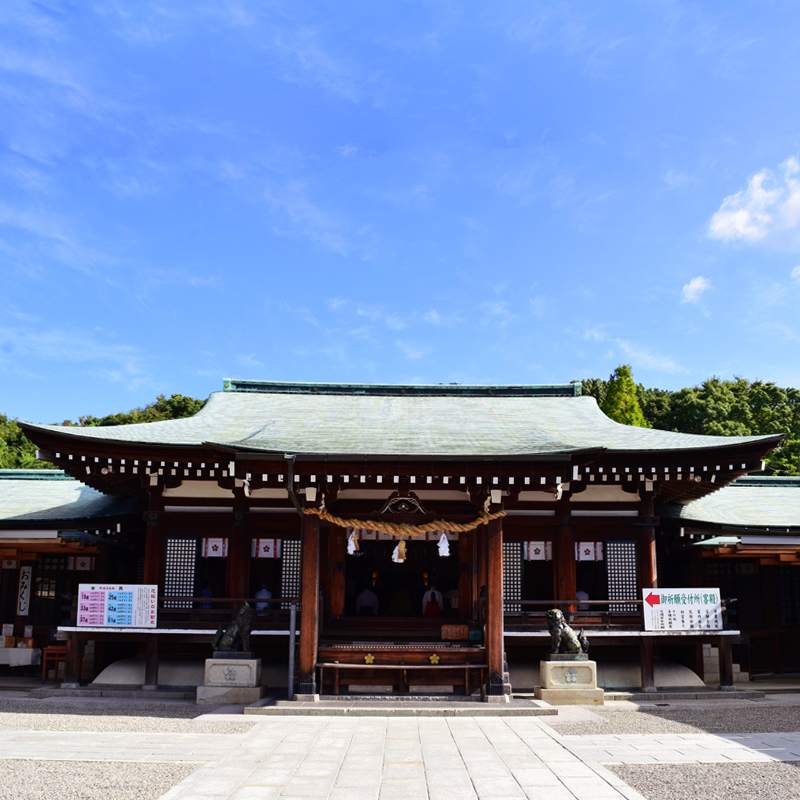
Photo:Honden
Sugawara no Michizane Biography
A minister in life: A God in death
Deified as the god Tenjin after his death in 903, Sugawara no Michizane (845–903) was a historical figure from the Heian period (794–1185). The son of a scholarly aristocrat of middle rank, he rose under Emperor Uda’s patronage to be Minister of the Right, one of the top positions in the government, through sheer power of intellect rather than family connections. Michizane’s success eventually aroused the resentment of his more highly-born rivals. As a result, after Emperor Uda’s abdication in favor of his son, Emperor Daigo, Fujiwara no Tokihara, the Minister of the Left, invented false charges against Michizane that resulted in his banishment from the court in Kyoto. He was sent to the city of Dazaifu in Kyushu, which was the seat of government for Kyushu and the place where emissaries from China and Korea were received.
Before leaving Kyoto, Michizane begged Retired Emperor Uda to help clear his name. The last place Michizane stayed in Honshu was Hofu, then a provincial government administrative center. Michizane was received kindly because he had blood ties with the local Haji clan. He also lingered in Hofu because, still hoping that the charges against him would be dismissed as false, he was reluctant to make the final sea crossing over to Kyushu.
Michizane finally reached Dazaifu in 901 and died in 903, just two years later, of what legend says was a broken heart. The miracles that occurred in Hofu on the day of his death—a single beam of light shining into the sea, a mysterious cloud covering the peak of a nearby hill—convinced people that the soul of the man who had never wanted to leave Hofu and Honshu in the first place had returned in death. If his soul had come back, they reasoned, then it would need a place to live. That is why the Hofu Tenmangu Shrine was built in 904, just one year after Michizane’s death.
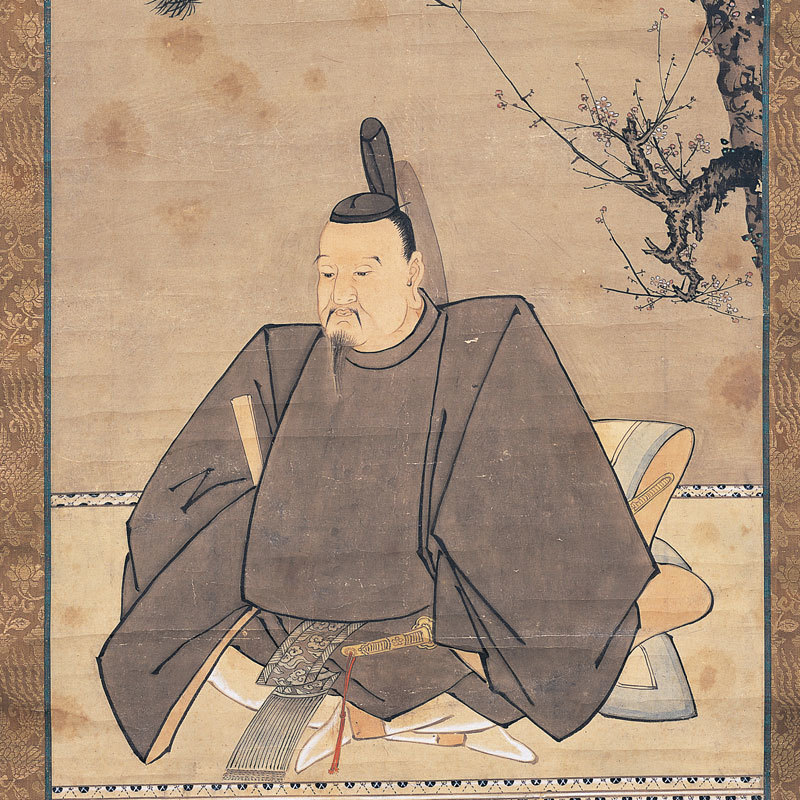
photo:Sugawara no Michizane
Hofu Tenmangu Shrine Museum
The Hofu Tenmangu Shrine Museum displays a selection from some six hundred items that were presented to the shrine as votive offerings. This is a brief overview of some of the most important.
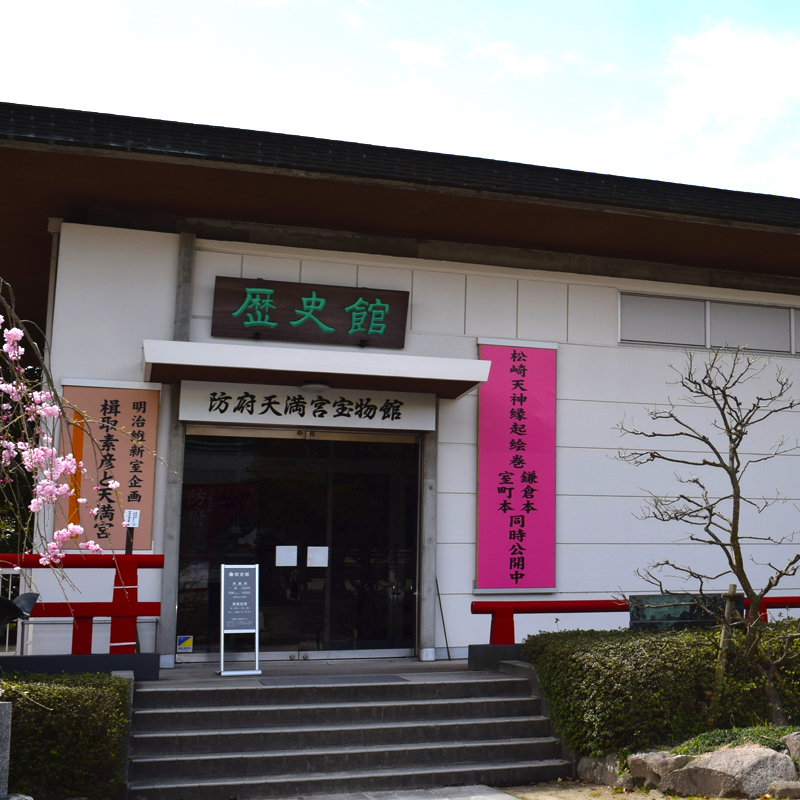
Photo:The Museum
Picture Scroll of the Shrine’s Origins
An illustrated biography 75 meters long
The most important exhibit in the museum is the Picture Scroll Showing the Origin of Matsuzaki Tenjin in Six Scrolls, Complete with Box (Matsuzaki Tenjin Engi Emaki Rokkan Hakotsuki).
This is a set of six illustrated scrolls, with a total length of 75 meters when placed end to end. There are two versions of the scroll: the original Kamakura Edition, which dates from 1331, just before the end of the Kamakura period (1185–1333), and a copy called the Muromachi Edition, which was made between 1504 and 1520 during the Muromachi period (1336–1573).
The first five scrolls recount all the classic legends about Sugawara no Michizane (845–903) both in life—bidding farewell to the plum tree in his Kyoto garden on his way into exile; the ox at his funeral sitting down and refusing to move—and as the deity Tenjin—hurling vengeful thunderbolts at his enemies, for example. The sixth scroll, however, is devoted entirely to the story of Hofu Tenmangu. (The Matsuzaki in the title comes from the fact that Hofu Tenmangu was originally known as Matsuzaki Shrine.)
It was forbidden to exhibit the original Kamakura Edition of the scrolls outside Hofu Tenmangu. As a result, it was seldom unfurled and exposed to the light, and so the colors are extraordinarily vivid and the paper quite wrinkle-free for something almost 700-years-old. Ironically, because of this prohibition, the Kamakura Edition copy is actually in better condition than the Muromachi Edition, despite being nearly two hundred years older!
In addition to its artistic value, illustrations from the scroll proved of great practical use when the shrine had to be rebuilt after burning to the ground in 1952, allowing it to be reconstructed according to the original plans.
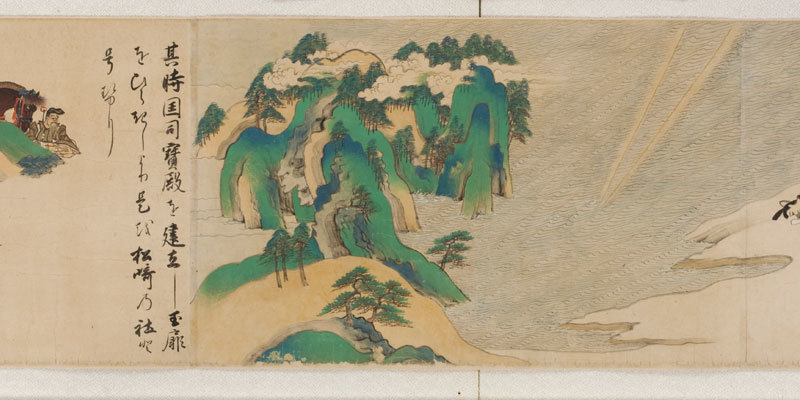
Photo:Matsuzaki Tenjin Engi Emaki
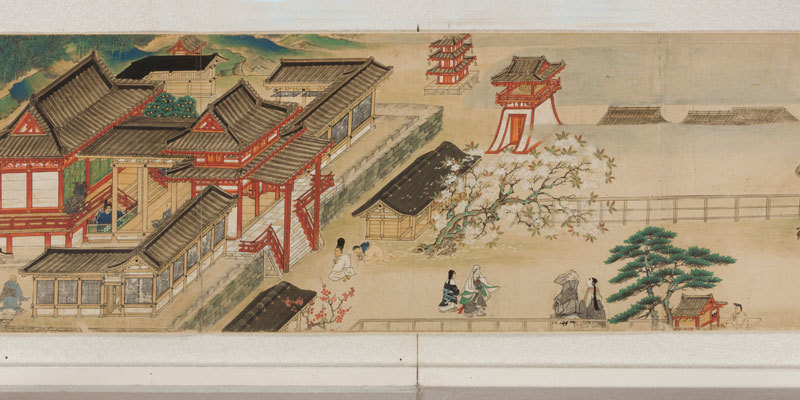
Photo:Matsuzaki Tenjin Engi Emaki
Copper-Gilt Treasure Pagoda
A pagoda for peace
This 40-centimeter-high Copper-Gilt Treasure Pagoda (Kondo-hoto) was presented to the shrine in 1172. It enshrines a bead of green glass designed to evoke an actual relic of the Buddha. In the late twelfth century when the pagoda was presented to the shrine, Japan was in a state of upheaval, as the imperial court was losing power to the shogun warlords. As the inscription on the pagoda explains, a local official, Fujiwara no Suesuk, presented the miniature pagoda to the temple to pray for the long life of Retired Emperor Go-Shirakawa, rich harvests in Suo Province (modern Yamaguchi Prefecture), and the well-being of the people. The Copper-Gilt Treasure Pagoda is the oldest artifact of known provenance in all 12,000 Tenjin shrines in Japan, which makes it uniquely precious.
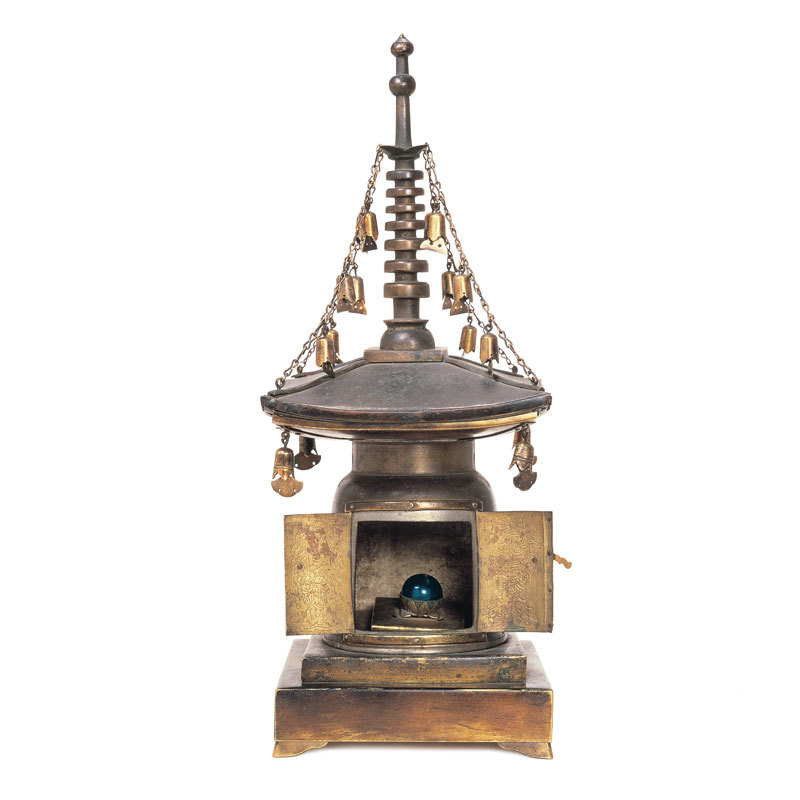
Photo:Kondo-hoto
Bonsho Bell
The spoils of war
Other exhibits include this bonsho, or Buddhist temple bell, which was struck to tell people the time. Dating from the Kamakura period (1185–1333), it was presented to the shrine by Ouchi Yoshitaka (1507–1551), the local daimyo, who had looted it from Tenfukuji Temple in Fukuoka.
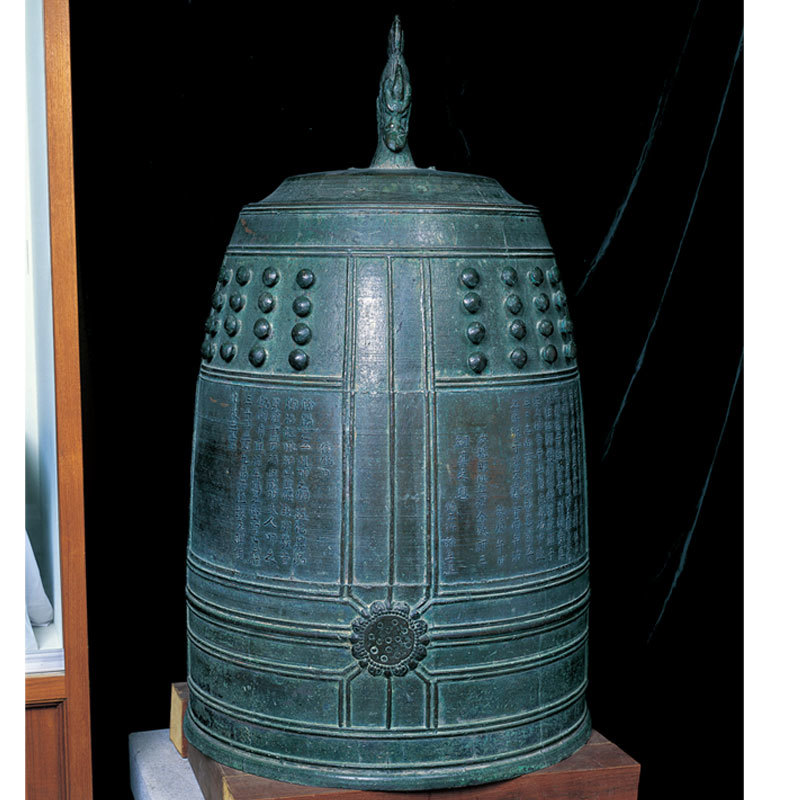
Photo:Bonsho
Hoshoan: Green Tea in a Green Garden
The Hoshoan (“Fragrant Pine Hermitage”) teahouse dates from 1991 and was built on the old site of the monks’ living quarters. In the ninth century, Sugawara no Michizane (845–903) revived the practice of drinking tea at the imperial court (though the tea itself had a rather more medicinal taste than today’s drink), and this teahouse pays homage to that legacy. The Hoshoan itself is a small traditional teahouse at the eastern end of the garden, but there is a much larger two-storied building in front. Both buildings overlook a beautiful garden intersected by a stream full of carp. The admission fee to the teahouse includes a cup of matcha green tea and some seasonal Japanese sweets. If you wish to follow proper etiquette when drinking your tea, pick up the bowl with your right hand, place it on the open palm of your left hand and then rotate it twice to the right, so that you do not drink from the front of the cup.

Photo: Fall garden
Gyotenro: A Secret Meeting Place for Revolutionaries
Immediately on the left as you enter the Hoshoan garden stands an old wooden building known as Gyotenro. This was once an outbuilding belonging to a local inn, where it was used for pickle-making. As the original staircase leading up to the second floor was retractable, it was the ideal place for having secret meetings. Many local samurai who played key roles in overthrowing the shogunate and restoring the emperor to power in the Meiji Restoration met here at Gyotenro.
Among the shishi, or “men of high purpose,” who had meetings here were Ito Hirobumi (1841–1909), who drafted Japan’s original constitution and became the country’s first prime minister in 1885, and Takasugi Shinsaku (1839–1867), who first proposed using non-samurai in the armed forces. They were all inspired by the example of Sugawara no Michizane (845–903), who had been a government official in life before becoming a god after death.
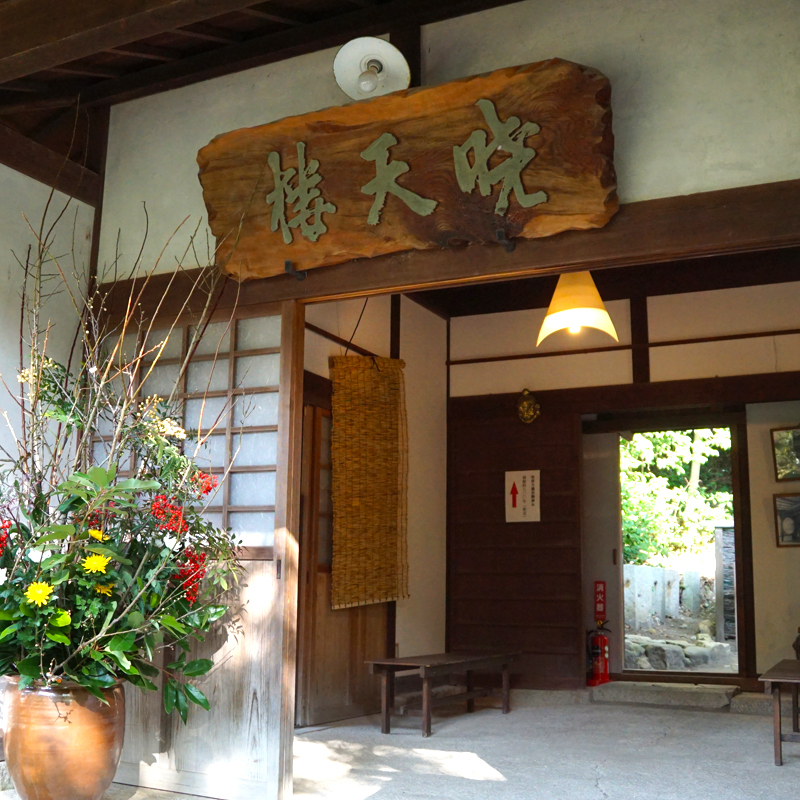
Photo:Gyotenro
Plum and Ox: Symbols of Legends
The plum and the ox are two key symbols associated with Sugawara no Michizane (845–903), the man who after his death became Tenjin, the god enshrined at Hofu Tenmangu Shrine. As an aristocratic aesthete of the Heian period (794–1185), Michizane was a great lover of flowers, plum blossoms in particular. Legend has it that when he was banished to Kyushu, he first stopped off at his Kyoto mansion to bid farewell to the plum tree in his garden. When Michizane got to Kyushu, his three favorite varieties of tree—the cherry, plum, and pine—are supposed to have tried to fly after him. The cherry withered away from loneliness; the pine tried to follow him but ran out of strength; only the plum tree made it all the way, flourishing and giving comfort to Michizane in his exile. In this way, the plum blossom became the symbol of Tenjin and appears as the crest of many Tenmangu shrines in Japan. It is also the reason why there are around 1,100 plum trees in the grounds of Hofu Tenmangu.
In Shinto, every god has their own designated animal servant or messenger. In the case of Michizane, that animal is the ox—and there is an anecdote that explains why. Michizane died in exile in Dazaifu in Kyushu in 903. Despite his disgrace, as a man of a certain stature he was still entitled to a grand funeral with an ox-cart to carry his body. As the funeral cortege was making its way to the burial ground, however, the ox pulling the cart sat down and refused to budge. This was interpreted to mean that Michizane wished to be buried precisely at that spot. Ever since, the seated ox has been one of the symbols of Tenjin, the deified Michizane, and it is believed that the deity is enshrined within seated oxen images. There are three statues of seated oxen at the Hofu Tenmangu.

Photo:Plum

Photo:Ox
Gojin-kosai: A Festival to Commemorate a Pardon
Every shrine in Japan has its own festival, and Hofu Tenmangu is no exception. The Gojin-kosai Festival has its roots in the origin story of Hofu Tenmangu. Tenjin, the god enshrined here, is the deified Sugawara no Michizane (845–903), an aristocratic administrator from the latter half of the ninth century who was exiled to Kyushu where he died, disgraced and unpardoned, in 903.
The Gojin-kosai Festival commemorates the events of the year 1004, when Emperor Ichijo finally issued a decree pardoning Michizane, 101 years after his death. The imperial messenger bearing the document arrived at Katsuma no Ura, the local harbor, now some distance inland after land reclamation. (This was the same harbor where Michizane had arrived when he came to Hofu in 901.) Every year, on the fourth Saturday in November, a boisterous crowd of thousands pulls a huge wheeled portable shrine housing Tenjin down the shrine steps to the site of the old harbor some 2.5 kilometers from the shrine. A ceremony takes place and the shrine is then pulled back again.
The festival is also known as the hadakabo-matsuri, the naked monk festival, because many of the participants wear only a white loin cloth, their nakedness symbolizing the idea of serving the god in a pure and natural state.
Another reason for shrine festivals is that the gods can get weary responding to people’s requests day in, day out, so when a crowd of believers take the god out of the shrine precincts and give his spirit a good shaking, it reinvigorates him and provides him with the energy to deal with another year’s worth of prayers and requests from his human supplicants.

Photo:Gojin-kosai Festival
この翻訳について
このサイトの解説文は観光庁の地域観光資源の多言語解説整備事業で作成しました。
Official Site
Information
◆Name of the historical building
Hofu Tenmangu Shrine
◆Address
14-1 Matsuzaki-cho,Hofu City,Yamaguchi Prefecture
◆Phone number
0835-23-7700
◆Traffic access
Take Bocho Bus at North Exit of Hofu station board for Amidaji and get off at Hofu Tenmangu bus stop.
It takes about 4 minutes.
◆Parking areas
Available
◆Barrier-free toilets
Available
Detail:Yamaguchi Prefecture Tourism Federation website “Come to Yamaguchi” barrier-free information page
◆The MuseumOpening hours
9:00a.m. ~ 16:30 p.m.
◆Admission fee
Adult:\500
High school students and younger:free
◆Hoshoan Teahouse Opening hours
9:30a.m. ~ 16:00 p.m.
◆Closing
12/31
◆Admission fee
\500
